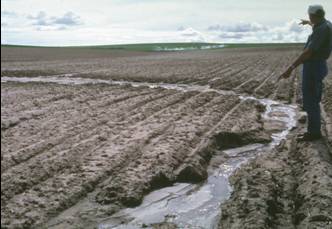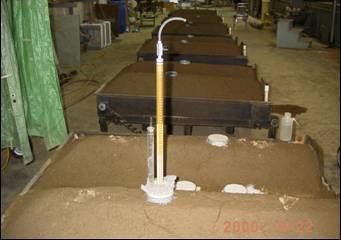 |
United States Department of Agriculture - Agricultural Research Service |  |
| Northwest Irrigation & Soils Research Lab, Kimberly, ID | ||
 |
United States Department of Agriculture - Agricultural Research Service |  |
| Northwest Irrigation & Soils Research Lab, Kimberly, ID | ||
 Use of PAM to Control Erosion From Raised Beds Under Sprinkler IrrigationD.J. Horne1, R.E. Sojka2, D.L. Bjorneberg2 and J.A. Foerster21Massey University, New Zealand IntroductionThe movement of soil from raised beds, as used to grow crops such as potatoes, and the associated slumping and degradation of beds is often a serious problem under sprinkler irrigation. Polyacrylamide (PAM) has proven very successful at mitigating similar problems in furrow irrigation. The objective of this study was to investigate the potential of PAM to control erosion and minimise damage to raised beds under sprinkler irrigation.  MethodSoil was placed in a series (6) of boxes (1.2 x 1.5 m) and ridged to resemble raised beds. The boxes were irrigated by an overhead sprinkler.TreatmentsThree of the boxes were irrigated with water and 3 were irrigated with PAM solution.SoilsTwo contrasting soil types were used - a medium textured soil (Portneuf silt loam) and a fine textured soil (Roza silty clay).PAMEach soil was irrigated 4 times: irrigation events were approximately one week apart.The 1st irrigation - PAM was applied at 3 kg ha-1 i.e. a 15 ppm solution was irrigated for 15 mins at 80 mm hr-1. The 2nd 3rd and 4th irrigations - PAM was applied at 0.66 kg ha-1 i.e. a 5 ppm solution was irrigated for 10 minutes.  Results
 Change in volumetric moisture content of ridges of silty clay.
ConclusionsBy protecting soil structure, PAM significantly improved irrigation efficiency on both soils i.e. with PAM, there was less water and sediment runoff, less slumping of the raised bed profile, increased wetting of the raised bed, increased infiltration rates, and enhanced aggregate stability. The results presented here suggest an important role for PAM in sprinkler irrigation of raised beds. | ||||||||||||||||||||||||
Back to PAM Research Project Page
*Disclaimer*
Posters, by their nature, are preliminary findings. These data and their interpretation may be refined or changed before formal publication. We encourage the user to benefit from their early insight into our most recent research, but not to regard them as the "final word" on these findings.